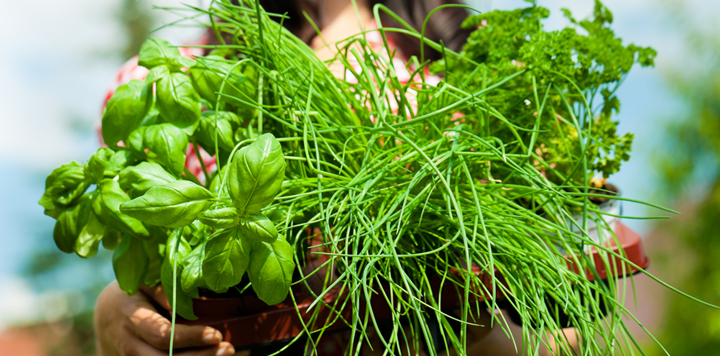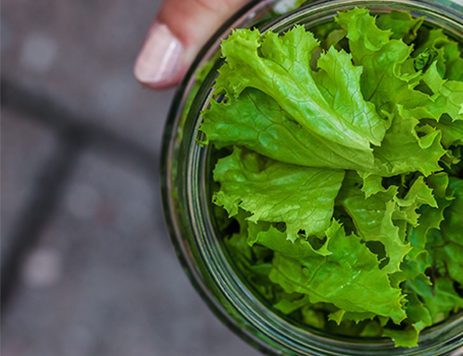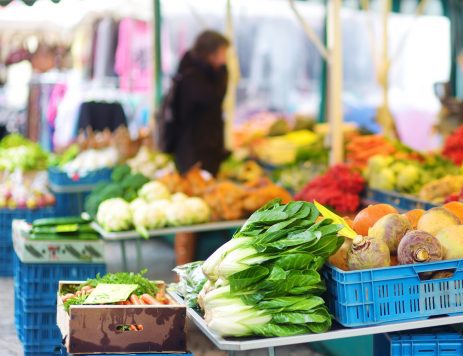
DIY: How to Start an Herb Garden in Your Backyard
Nothing beats the taste of fresh herbs, picked right before you cook. Whether you have a green thumb or you’re an agricultural novice, growing an herb garden is easily achievable. Follow this step-by-step guide to growing your own DIY herb garden.
Planning the Garden
First, create a list of the herbs you plan to grow, along with their soil, light and water needs. Draw your herb garden to scale, considering the height and width (known as the spread) of each plant. Arrange tall herbs in the back and low-growing herbs in front to ensure maximum sunlight coverage for all of the plants. Then, decide what kind of garden you want: indoor to outdoors. The kitchen is an ideal location for indoor gardens, but any spot with at least six hours of sunlight a day will work.
| Herb | Type | Height | Spread | Spacing | Water | Germination | Best With |
| Basil | Annual | 18-24″ | 10″ | 12-18″ | Lightly every day | 7-14 days | Tomatoes, cucumbers, lamb, fish, salad, cheese, pizza, soups, pasta, Italian dishes |
| Chives | Perennial | 8-15″ | 8″ | 8-12″ | Every other day | 7-21 days | Asparagus, carrots, cauliflower, chicken, corn, fish, tomatoes, rice, potatoes, eggs, herb butter |
| Cilantro | Annual | 12-24″ | 4″ | 6-12″ | Every other day | 7-14 days | Fish, avocados, peppers, chicken, sauces, Mexican food, Indian dishes, Thai noodles |
| Dill | Annual | 15-20″ | 6″ | 12-20″ | Lightly ever day | 21-28 days | Seafood, dips, cucumber, eggs, potatoes, carrots, salad greens, pickles, biscuits |
| Fennel | Perennial | 50-72″ | 18-36″ | 18″ | Lightly every day | 7-14 days | Pork, fish, sauces, stuffing, grain salads, slaw |
| Majoram | Perennial | 8-24″ | 12-18″ | 18-24″ | Every other day | 7-14 days | Vegetable soup, cheese dishes, beans, roast chicken, beef, stuffing |
| Oregano | Perennial | 16-18″ | 12″ | 12-15″ | Every 2-3 days | 7-14 days | Italian tomato sauces, lamb, beef, pizza, chili, stuffing, Greek food |
| Parsley | Biennial | 12-18″ | 8″ | 10-18″ | Lightly every day | 14-28 days | Beef, fish, poultry, pork, potatoes, eggplant, soups, eggs, cheese, as garnish |
| Rosemary | Perennial | 12-36″ | 18-24″ | 12-20″ | Every other day | 14-28 days | Poultry, grilled lamb, stuffing, marinades, potatoes, bread |
| Sage | Perennial | 18-30″ | 24″ | 20-36″ | 1-2X a week | 14-21 days | Sausage stuffing, pok roast, veal, meatballs |
| Thyme | Perennial | 1-18″ | 12-18″ | 16-24″ | Every 2-3 days | 21-28 days | Marinades, bread pudding, beef, chicken, cheese, bean and vegetable soups |
Planting Your Herbs
The next step is planting. High quality soil is essential: look for rich, fertile soil that contains phosphorous and potassium and has a pH level between 6.0 and 7.0. Once you have the soil, it’s time to dig. Plants should have enough space between them so that they don’t block each other’s light, but be close enough that weeds won’t invade. Pro tip: add labels to each of your herbs while you plant them for easy identification when caring for, harvesting and cooking with them.
Maintaining Your Herb Garden
Most herbs require ample sunlight and regular watering (refer to the above chart), but be careful not to overdo it. Herbs tend to flourish with little care, so just turn the soil with a hand tiller or spade in the first few weeks and prune when you see fit.
Harvesting Your Herbs
Check on your herbs regularly, especially as they near mature height. They will be most flavorful when you can see the flower buds forming, but before they reach full bloom. Aim to gather herbs in the morning, after the dew has dried and before the plant’s aromatic oils have been heated by the sun. Cutting close to a branch or leaf intersection will allow your plant to regrow quickly.
Storing Your Herbs
Storing herbs for a short duration is simple. Long stem herbs, like cilantro, basil and parsley, should be trimmed and stored in a glass of water like fresh flowers. Short stem herbs, like thyme and rosemary, should be wrapped in a damp paper towel and placed in a perforated plastic bag in your refrigerator. Herbs stored in your refrigerator should be used within the week. For long-term storage, consider hang drying or freezing.
Hang drying
Drying your herbs will help retain flavor best.
For low-moisture, sturdy herbs, like thyme, dill, rosemary and sage:
- cut the branches
- rinse in cool water
- hang upside down for 2-3 weeks
- remove the leaves
- store in an air-tight container
For large leaf, moist herbs like basil:
- remove the best leaves
- place them in a single layer on a netted surface
- let the rack sit in a shady and well-ventilated room, turning leaves occasionally for a week
- store in an air-tight container
Freezing
You can also freeze your herbs:
- remove the best leaves
- wash and pat dry
- spread into single layer on a cookie sheet
- place cookie sheet in freezer until leaves freeze
- move to air-tight container and store in the freezer
No matter what method you use for longer-term storage, be sure to grind or crush your leaves before using them. If the leaves turn black or grow mold, discard the bunch. There should be plenty of fresh herbs from your blossoming garden to choose from!



